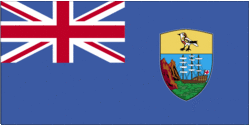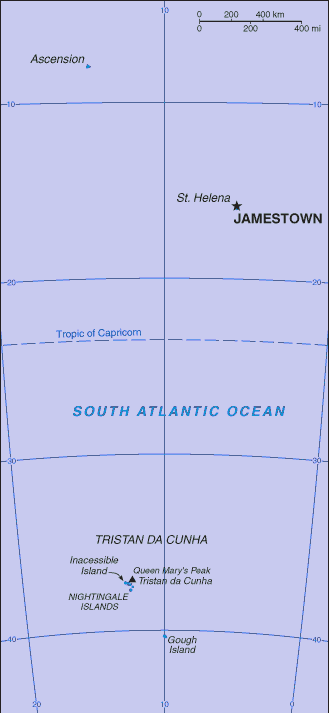Traveling Luck for Saint Helena. Saint Helena, Africa
Saint Helena is located in islands in the South Atlantic Ocean, about midway between South America and Africa; Ascension Island lies 700 nm northwest of Saint Helena; Tristan da Cunha lies 2300 nm southwest of Saint Helena.
Land in Saint Helena is the islands of this group result from volcanic activity associated with the Atlantic Mid-Ocean Ridge
Saint Helena: rugged, volcanic; small scattered plateaus and plains
Ascension: surface covered by lava flows and cinder cones of 44 dormant volcanoes; ground rises to the east
Tristan da Cunha: sheer cliffs line the coastline of the nearly circular island; the flanks of the central volcanic peak are deeply dissected; narrow coastal plain lies between The Peak and the coastal cliffs.
Saint Helenian land covers an area of 413 square kilometers which is slightly more than twice the size of Washington, DC
 Saint Helenian national flag (Flag of Saint Helena)
Saint Helenian national flag (Flag of Saint Helena)
As for the Saint Helenian climate; Saint Helena: tropical marine; mild, tempered by trade winds
Ascension Island: tropical marine; mild, semi-arid
Tristan da Cunha: temperate marine; mild, tempered by trade winds (tends to be cooler than Saint Helena).
Saint Helenian(s) speak English.
Places of note in Saint Helena
 Saint Helenian map
Saint Helenian map
Regions of Saint Helena
Saint Helena is a British Overseas Territory consisting of Saint Helena and Ascension Islands, and the island group of Tristan da Cunha.
Saint Helena: Uninhabited when first discovered by the Portuguese in 1502, Saint Helena was garrisoned by the British during the 17th century. It acquired fame as the place of Napoleon BONAPARTE's exile, from 1815 until his death in 1821, but its importance as a port of call declined after the opening of the Suez Canal in 1869. During the Anglo-Boer War in South Africa, several thousand Boer prisoners were confined on the island between 1900 and 1903.
Ascension Island: This barren and uninhabited island was discovered and named by the Portuguese in 1503. The British garrisoned the island in 1815 to prevent a rescue of Napoleon from Saint Helena and it served as a provisioning station for the Royal Navy's West Africa Squadron on anti-slavery patrol. The island remained under Admiralty control until 1922, when it became a dependency of Saint Helena. During World War II, the UK permitted the US to construct an airfield on Ascension in support of trans-Atlantic flights to Africa and anti-submarine operations in the South Atlantic. In the 1960s the island became an important space tracking station for the US. In 1982, Ascension was an essential staging area for British forces during the Falklands War, and it remains a critical refueling point in the air-bridge from the UK to the South Atlantic.
Tristan da Cunha: The island group consists of the islands of Tristan da Cunha, Nightingale, Inaccessible, and Gough. Tristan da Cunha is named after its Portuguese discoverer (1506); it was garrisoned by the British in 1816 to prevent any attempt to rescue Napoleon from Saint Helena. Gough and Inaccessible Islands have been designated World Heritage Sites. South Africa leases the site for a meteorological station on Gough Island.
The economy depends largely on financial assistance from the UK, which amounted to about $5 million in 1997 or almost one-half of annual budgetary revenues. The local population earns income from fishing, raising livestock, and sales of handicrafts. Because there are few jobs, 25% of the work force has left to seek employment on Ascension Island, on the Falklands, and in the UK.
Saint Helenian natural resources include fish, lobster
Saint Helena harbors at least 40 species of plants unknown anywhere else in the world; Ascension is a breeding ground for sea turtles and sooty terns; Queen Mary's Peak on Tristan da Cunha is the highest island mountain in the South Atlantic and a prominent landmark on the sea lanes around southern Africa
Saint Helenian religion is Anglican (majority), Baptist, Seventh-Day Adventist, Roman Catholic.
Natural hazards in Saint Helena include active volcanism on Tristan da Cunha, last eruption in 1961.
Travel Advice for Saint Helena
St HelenaSUMMARY
- St Helena is a British Overseas Territory and all “Saints” are British nationals. There is no formal British diplomatic or consular representation in St Helena and the local authorities deal with all requests for consular assistance. The General section of this travel advice gives you more information about this.
- St Helena does not have an air link. All journeys are by sea, via Cape Town, Ascension Island or Walvis Bay. You should therefore consult the travel advice relating to the country through which you intend to travel.
- The threat from terrorism is low. But you should be aware of the global risk of indiscriminate terrorist attacks which could be against civilian targets, including places frequented by foreigners.
- A good standard of medical care is available on St Helena but it is not free. Costs can be high and you must obtain comprehensive travel and medical insurance to cover treatment costs, as well as medical evacuation if this becomes necessary. Medical evacuations depend on the schedule of the RMS St Helena. You should check any exclusions, and that your policy covers you for the activities you want to undertake. Please see: Travel Insurance.
SAFETY AND SECURITY
Credit Cards are accepted at some outlets on the Island.
St Helena currency is used on the island and the St Helena pound is fixed at parity with pound Sterling. Travellers’ cheques are also recommended whilst on holiday and can be cashed at the Bank of St Helena, Jamestown. The Bank of St Helena also offers foreign exchange facilities.
OTHER

 Search
Search Travel advice for Saint Helena
Travel advice for Saint Helena